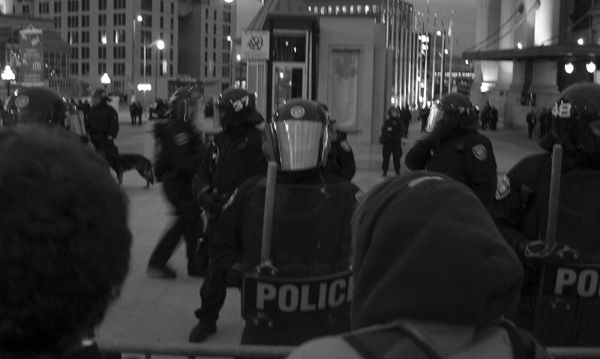* Jan 31, 2008: See update at bottom.
I had one of those ‘this isn’t happening’ moments yesterday afternoon, when a colleague in Ottawa emailed me a breaking story with the headline: Harkat Arrested for Alleged Bail Violation. Mohamed Harkat is one of the Secret Trial Five, an ‘Individual Subject to Security Certificate’ or ISSC in governmentspeak (*see bottom of post). Between June 21, 2006 and yesterday afternoon, Mohamed had been released from custody on strict bail conditions. Between April and June 2006, he was briefly held at the Kingston Immigration Holding Centre (KIHC). He was arrested on a security certificate on December 10, 2002, and between that time and the opening of KIHC, he was held in provincial detention. At no point has he been charged with a crime. Mohamed’s bail conditions remain among the most severe in Canadian history, and they effectively place him, his wife and most vocal advocate Sophie, and his mother in law, inside a bubble of complete surveillance and control. Putting aside for a moment the absurdity of a mechanism that can enforce strict bail conditions for someone who has never committed a crime, it is important to note that the Harkats have done everything they can to comply with the terms of his release. And, for over a year, Sophie and Mohamed, while still advocates for the abolition of security certificates, have lived in a state of comparable normalcy, understanding strict bail to be a lesser evil compared to indefinite detention. They were due to appear before the Federal Court next Monday to apply for the relaxation of some conditions.
Normalcy came to an end yesterday when ‘agents’ of the Canada Border Services Agency (CBSA) burst into the Harkats’ Ottawa home and arrested Mohamed for violating the conditions of his bail. He is now in custody, at the Ottawa Jail on Elgin Street. Should the Federal Court decide that the alleged breach of bail was significant enough to warrant incarceration, it is likely that Mohamed will be transported to Bath, Ontario, to KIHC, where he would join fellow ‘ISSD’ Hassan Almrei (who is currently the only detainee at the facility).
Reports on the allegations against Mohamed Harkat were sketchy at first, but the media seems to have pieced things together by this morning. Note that the story has already migrated away from the headlines of the main news sites.
From the Globe and Mail:
[...] Canadian Border Services Agency officials arrested 39-year-old suspect Mohamed Harkat. The breach of bail accusation apparently stems from Mr. Harkat's mother-in-law - one of his guardians and the owner of the Ottawa house where he and his wife Sophie lived - no longer residing in the home, according to Mr. Harkat's lawyer, Paul Copeland.
From the CBC:
Sophie Harkat said that agents from the Canada Border Services Agency came to the house a few days earlier and took photos of some of her mother's possessions in boxes.
She said her mother is looking for a new place to live after separating from her longtime partner.
Copeland also said the conditions had not been breached, saying he suspects the raid might have been related to an upcoming court case in which Harkat plans to argue for a loosening of his stringent bail conditions. That federal court case will take place next week.
See also reports from the Ottawa Citizen, CTV.ca, (the original Canadian Press flash) and, for a roundup and regular updates, the Justice Coalition for Mohamed Harkat.
I have a few comments about this story.
First, I think that Canadians should be appalled at the actions of the Canada Border Services Agency, whose actions yesterday were, at best, thuggish and wholly disproportionate to the demands of the situation. They barged into the house unannounced, in force, and arrested Mohamed while he was in the shower. To appreciate the absurdity of this, you have to understand how closely the Harkats have been monitored by CBSA since he was released on bail. They are under constant surveillance, and 24-hour supervision. He wears an electronic monitoring bracelet at all times, and all of his communications are tapped. He has never been uncooperative with the CBSA, and the Harkats, Sophie in particular, have dedicated an enormous amount of time and energy to challenging the validity of security certificates before both the Federal and Supreme Courts - ergo the absolute last thing that either of them would do, at this point, is jeopardize their case by resisting the CBSA. There was no need for an unannounced daytime raid. I guarantee that a pair of officers politely knocking at the door and explaining the situation would have been met with full cooperation. The Harkats are at the forefront of the campaign against security certificates, but the terrain of their battle is the courtroom, not the living room. This is yet another example of Canadian authorities exercising power and displaying force for its own sake. Well, maybe not for its own sake - which brings me to my second point.
I would suggest that this entire escapade was political, part of a government effort to demonstrate the need for its C-3 security certificate legislation. At the risk of sounding like a conspiracy theorist, let me lay out a brief timeline to explain myself:
Context: In February, 2007, the Supreme Court in Charkaoui struck down certificates on Charter grounds, but withheld the effect of their ruling for one year, in order to give the government time to create a ‘Charter-proof’ security certificate regime. In late fall 2007, the government tabled C-3. When Parliament adjourned for its lengthy winter break, C-3 had just returned from committee, and was ready to be read a third time and then passed on to the Senate. See my earlier posts on C-3 for a discussion of the political discourse surrounding the legislation.
January 18, 2008: A Federal Court Judge orders (see here as well) reporters with La Presse to reveal their sources for a June story that referenced leaked CSIS documents that smeared Adil Charkaoui, another individual subject to security certificate.
January 27, 2008: A previously-unseen CSIS report mysteriously emerges and finds its way into Adil Charkaoui’s Federal Court file. CSIS claims to have recently discovered the report, based on an April 2001 interview with Charkaoui. The circumstances surrounding the discovery of the report are highly suspicious, leading many to accuse CSIS of attempting to smear Charkaoui prior to an upcoming Federal Court appearance.
January 28, 2008: Parliament resumes after the winter break. The Order Paper and Notice Paper for the House of Commons list C-3 as an agenda item, as does the projected order of business. The government is grilled about the Afghanistan detainees scandal, and the 18:30 close of day arrives before C-3 is discussed.
January 29, 2008: The Parliament agenda, published in the morning, does not include C-3, which appears to have been ‘bumped’. Around 15:00, CBSA agents enter the Harkat residence and arrest Mohamed Harkat for an alleged bail violation. Lawyers for Mohamed Harkat suggest that the arrest is a theatrical event designed to smear Harkat prior to his upcoming Federal Court appearance (see a pattern?), and to provide the government with convenient (fabricated) ammunition for the upcoming C-3 vote.
January 30, 2008: The projected order of business for Parliament today includes several bills, but C-3 remains missing.
The pattern: Parliamentary debate and the vote over C-3 has been postponed at the same time that the two most vocal members of the Secret Trial Five - both of whom have pending Federal Court appearances - have been the subject of government action. In the case of Charkaoui, a damning CSIS file has mysteriously fallen from the sky. In the case of Harkat, a vague accusation of bail violation stemming from speculations on the living arrangements of his mother in law has resulted in his arrest.
The result: When C-3 does come before the House, the government will be able to reference recent allegations regarding Harkat and Charkaoui as part of its argument. It doesn’t matter that both cases are dubious; for the Conservatives, a ‘tough on terror’ talking point just needs to sound good. This, combined with the rapidly-approaching end-of-February deadline on security certificate reform imposed by the Supreme Court, will allow the government to rush C-3 through third reading.
This may not reflect a plan. It may just be convenient, coincidental timing. I’m inclined to think otherwise, though. The history of the past 6.5 years tells us that major policy decisions on matters of national security tend to be curiously preceded by unexpected ‘revelations’ or news-grabbing non-events related to terrorism. Draw your own conclusions.
A final thought: For the last several years, members of the Secret Trial Five have gradually been released on strict bail conditions, starting with Charkaoui, then Harkat, then Jaballah and Mahjoub, until now only Almrei is behind bars. The bail conditions are unbelievably strict, and they require a tremendous sacrifice from the families of the detainees, who must agree to restructure their lives and submit to Orwellian surveillance, in order to secure quasi-freedom for their loved ones. I have argued in the past that these conditions represent a form of collective punishment, in that they subject a group of people to invasive discipline and control on the basis of familial relation or close association with an individual deemed (but never proved) threatening. I’m certain that the families of the detainees released on bail would agree with this assessment, but they also experience the bail conditions as a ‘lesser evil’, with the alternative being the indefinite incarceration of a husband, son, or father. As such, while they have continued to campaign for the general abolition of security certificates and the relaxation of bail conditions in specific cases, the families and supporters of the Secret Trial Five have not been able to truly condemn the injustice of the bail regime, for fear that the government would respond by returning the men to prison.
But yesterday’s events should speak for themselves as a condemnation of a manifestly unjust system. Place yourself in the position of Sophie Harkat’s mother: Your son-in law has just been arrested and incarcerated because government agents drew conclusions about your living arrangements based a change in your relationship status. Imagine the sense of guilt.
Security certificates are an affront to justice, and they cannot be legitimized. They are, to use David Dyzenhaus’ term, ‘unlegalizable’. They circumvent the court system, operate under a veil of secrecy, and force people to make impossible choices (indefinite detention or ‘voluntary’ deportation to probable torture? Let someone rot in jail or reorganize my entire life and the lives of my family to supervise them on indefinite bail?).
We need to get rid of security certificates. I encourage all readers to contact their MPs and demand a vote of NO on C-3.
Mike
* Something to add to your dictionaries of governmentspeak. It seems that the Canada Border Services Agency is somewhat torn about what to call the people it keeps behind bars at KIHC. I have recently received the KIHC President’s Directives, Standing Orders, and Post Orders, following a request under the Access to Information Act. While many documents refer to them as ‘Detainees’, some President’s Directives have switched to the term ‘Individual Subject to Security Certificate’ or ISSC. This may reflect the well-established fixation on acronyms that characterizes the Canadian government bureaucracy. I suspect that it also reflects an understanding of the political weight attached to the term ‘detainee’, which generally conjures images of prisoner transfers in Afghanistan.
An example, from CBSA KIHC President’s Directive 081 on Redress Process:

Update (January 31, 2008):
Some additional information and resources regarding Mohamed Harkat's current situation:
- See YaYaCanada's excellent coverage of the story, with some information about the arrest and follow-up that you won't find in the mainstream media, along with some photos.
- The Justice for Mohamed Harkat site has a report from an interview Sophie Harkat did with the Ottawa Sun, talking about her experience.
- CBC.ca follow-up, talking about the likelihood that Mohamed will be spending Thursday night at the Ottawa-Carleton Detention Centre.



